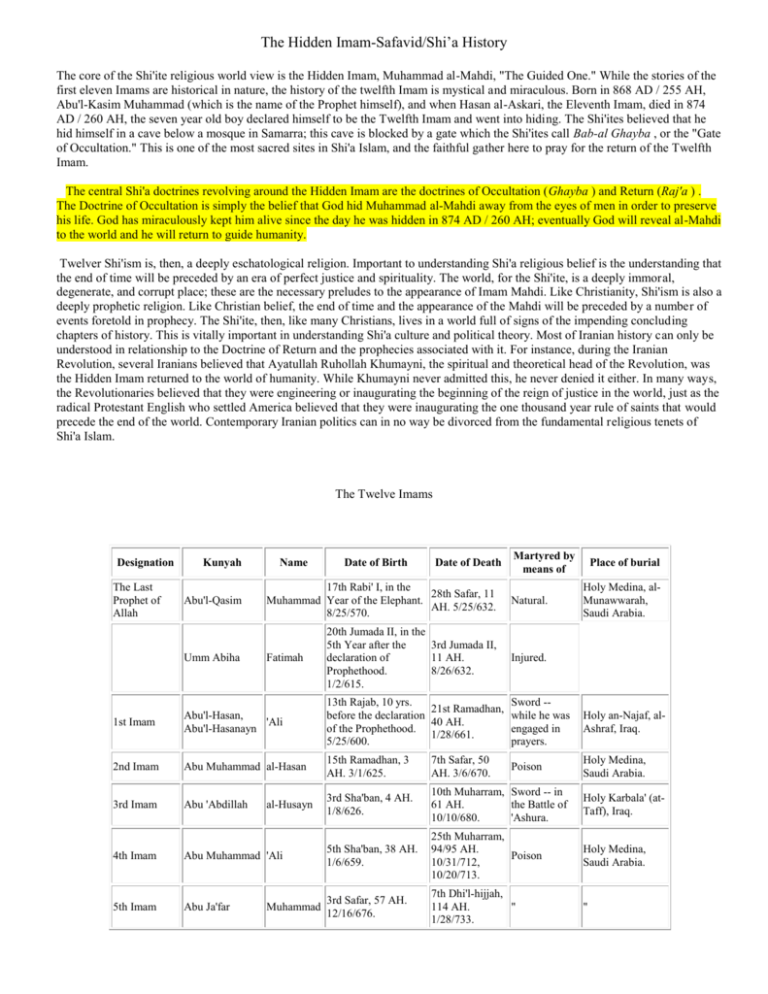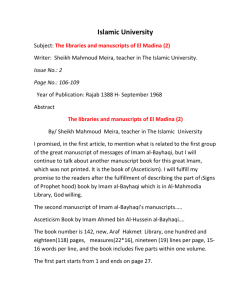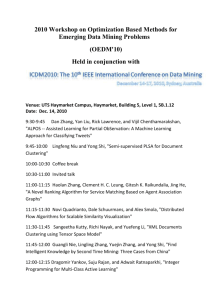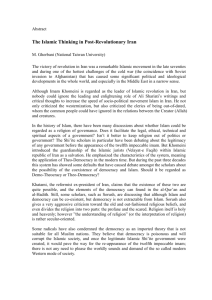Safavid Notes - Buncombe County Schools
advertisement

The Hidden Imam-Safavid/Shi’a History The core of the Shi'ite religious world view is the Hidden Imam, Muhammad al-Mahdi, "The Guided One." While the stories of the first eleven Imams are historical in nature, the history of the twelfth Imam is mystical and miraculous. Born in 868 AD / 255 AH, Abu'l-Kasim Muhammad (which is the name of the Prophet himself), and when Hasan al-Askari, the Eleventh Imam, died in 874 AD / 260 AH, the seven year old boy declared himself to be the Twelfth Imam and went into hiding. The Shi'ites believed that he hid himself in a cave below a mosque in Samarra; this cave is blocked by a gate which the Shi'ites call Bab-al Ghayba , or the "Gate of Occultation." This is one of the most sacred sites in Shi'a Islam, and the faithful gather here to pray for the return of the Twelfth Imam. The central Shi'a doctrines revolving around the Hidden Imam are the doctrines of Occultation (Ghayba ) and Return (Raj'a ) . The Doctrine of Occultation is simply the belief that God hid Muhammad al-Mahdi away from the eyes of men in order to preserve his life. God has miraculously kept him alive since the day he was hidden in 874 AD / 260 AH; eventually God will reveal al-Mahdi to the world and he will return to guide humanity. Twelver Shi'ism is, then, a deeply eschatological religion. Important to understanding Shi'a religious belief is the understanding that the end of time will be preceded by an era of perfect justice and spirituality. The world, for the Shi'ite, is a deeply immoral, degenerate, and corrupt place; these are the necessary preludes to the appearance of Imam Mahdi. Like Christianity, Shi'ism is also a deeply prophetic religion. Like Christian belief, the end of time and the appearance of the Mahdi will be preceded by a number of events foretold in prophecy. The Shi'ite, then, like many Christians, lives in a world full of signs of the impending concluding chapters of history. This is vitally important in understanding Shi'a culture and political theory. Most of Iranian history can only be understood in relationship to the Doctrine of Return and the prophecies associated with it. For instance, during the Iranian Revolution, several Iranians believed that Ayatullah Ruhollah Khumayni, the spiritual and theoretical head of the Revolution, was the Hidden Imam returned to the world of humanity. While Khumayni never admitted this, he never denied it either. In many ways, the Revolutionaries believed that they were engineering or inaugurating the beginning of the reign of justice in the world, just as the radical Protestant English who settled America believed that they were inaugurating the one thousand year rule of saints that would precede the end of the world. Contemporary Iranian politics can in no way be divorced from the fundamental religious tenets of Shi'a Islam. The Twelve Imams Designation The Last Prophet of Allah Kunyah Name Date of Birth Date of Death Martyred by means of Place of burial Abu'l-Qasim 17th Rabi' I, in the 28th Safar, 11 Muhammad Year of the Elephant. AH. 5/25/632. 8/25/570. Natural. Umm Abiha 20th Jumada II, in the 5th Year after the 3rd Jumada II, declaration of 11 AH. Prophethood. 8/26/632. 1/2/615. Injured. 1st Imam Abu'l-Hasan, 'Ali Abu'l-Hasanayn 13th Rajab, 10 yrs. 21st Ramadhan, before the declaration 40 AH. of the Prophethood. 1/28/661. 5/25/600. Sword -while he was engaged in prayers. Holy an-Najaf, alAshraf, Iraq. 2nd Imam Abu Muhammad al-Hasan 15th Ramadhan, 3 AH. 3/1/625. 7th Safar, 50 AH. 3/6/670. Poison Holy Medina, Saudi Arabia. 3rd Imam Abu 'Abdillah 3rd Sha'ban, 4 AH. 1/8/626. 10th Muharram, Sword -- in 61 AH. the Battle of 10/10/680. 'Ashura. Holy Karbala' (atTaff), Iraq. 25th Muharram, 94/95 AH. Poison 10/31/712, 10/20/713. Holy Medina, Saudi Arabia. 7th Dhi'l-hijjah, 114 AH. " 1/28/733. " Fatimah al-Husayn 4th Imam Abu Muhammad 'Ali 5th Sha'ban, 38 AH. 1/6/659. 5th Imam Abu Ja'far 3rd Safar, 57 AH. 12/16/676. Muhammad Holy Medina, alMunawwarah, Saudi Arabia. 17th Rabi' I, 83 AH. 4/20/702. 25th Shawwal, 148 AH. 12/14/765. 7th Imam Abu'l Hasan (alAwwal = the Musa First), Abu Ibrahim 7th Safar, 129 AH. 10/28/746. 25th Rajab, 183 " AH. 9/1/799. 8th Imam Abu'l Hasan (ath-Thani = the 'Ali Second) 11th Dhi'l-qi'dah, 148 17th Safar, 203 " AH. 12/29/765. AH. 8/24/818. Holy Mash'had (Tus-Khurasan), Iran. 9th Imam Abu Ja'far (athThani = the Second) Muhammad 30th Dhi'l10th Rajab, 195 AH. qi'dah, 220 AH. " 4/8/811. 11/25/835. Holy alKazimiyyah, Iraq. 10th Imam Abu'l Hasan (ath-Thalith = the Third) 'Ali 2nd Rajab, 212 AH. 9/27/827. Holy Samarra' (Surra-man-ra'a), Iraq. 11th Imam Abu Muhammad al-Hasan 8th Rabi' II, 232 AH. 8th Rabi' I, 260 " 12/3/846. AH. 1/1/874. " 12th Imam Abu'l-Qasim 15th Sha'ban, 255 AH. 7/29/869. --- 6th Imam Abu 'Abdillah, Abu Musa Ja'far Muhammad 3rd Rajab, 254 AH. 6/28/868. " " Still alive but in --occultation " Holy alKazimiyyah, Iraq. The Safavids-Notes The first large, lasting Shi'ite state was the Safavid state in Iran. The Safavids were originally a Turkish Sufi order; Sufism is a mystical branch of Sunni Islam. The leaders of this movement, the tariqa , passed on this leadership through hereditary means. The Safavids, then, were a kind of hereditary mystical spiritual authority. In the fifteenth century, the Safavids converted to Shi'ism and evolved a militant theology that demanded the supremacy of Shi'ism through force of arms. These militant Safavids claimed to be the direct descenedants of the seventh Imam. As their influence grew, they converted many Turks in Iran, Syria, and Anatolia Isma'il Claiming to be the Representative of the Hidden Imam, Isma'il, a young Safavid master, expanded Safavid control over much of Iran, Mesopotamia (Iraq), Azerbaijan, and the Caucusus south of Russia by 1506 AD. He had assumed control of the Safavids in 1494 AD / 900 AH (at the age of seven!), and appears to have gained a fanatical following by not only calling himself the representative of the Hidden Imam, but by claiming to be the Hidden Imam himself (later he would claim divinity). His followers believed that the Hidden Imam had returned and that they were soldiers in the forces of righteousness. Their victory, which was certain, would inaugurate a period of world-wide justice and spirituality. In 1499 (at the age of twelve!), Isma'il led his army in a war of conquest. In 1500, he conquered the kingdom of Shirvan, and in 1501, he was crowned King of Tabriz (at the age of fourteen). He then declared Shi'a Islam to be the state religion of Tabriz. By 1512, he controlled all of Iran (do the math yourself). Adopting Persian models of government and bureaucracy, Isma'il declared himself Shah of Iran and became the first Shah of the Safavid dynasty. He enforced Shi'ism on everyone; at the time, Sunni Muslims vastly outnumbered Shi'ites in Iran. He forced them to curse the first three Caliphs and to be ruled under the Shi'ite ulama . Here's a surprise. He succeeded. His efforts to turn Iran into a Shi'ite population was remarkably successful, and Iran to this day is almost entirely Shi'ite. Isma'il, however, came in conflict with the Ottomans; in a battle at Chaldiran in 1514, Isma'il was defeated by Selim I. From that point onwards, the Safavids and Ottomans were continually at war for more than two hundred years. The Ottomans slowly took territory from the Safavids; Isma'il's successor, Tahmasp I, who ruled from 1524 to 1576, lost enormous amounts of territory to the Ottoman Sultan Suleyman I. The Ottomans, however, never succeeded but they never succeeded in deposing the Safavids. Isma'il based his political authority on two claims. The first was his claim to inherit the Persian monarchy; the title of the Persian monarch was "Shadow of God on Earth." The second was his claim to be descended from the Seventh Imam and to be the "Representative of the Hidden Imam" (na'ib al-khass ). This latter claim, however, was heretical, for the doctrine of Greater Occultation asserts that the Hidden Imam will have no representative on earth until his reappearance. This heresy, however, was accepted and Shi'ites happily believed the Safavid Shahs to be the Representatives of the Hidden Imam. In the nineteenth century, this title would be transferred to the Shi'ite ulama . This is again heretical, but it lies behind the Iranian respect of the ulama and is a fundamental reason for the position the ulama occupies in the current Islamic republic of Iran. Abbas I Both Islamic and Western historians agree that the reign of Shah Abbas I (1588-1629) was the greatest period in Safavid history and culture. He turned back the Ottoman tide and reseized vast amounts of territory, including Azerbaijan and Iraq. He was the first Iranian ruler to turn to Europe; in order to check the Ottomans, he made alliances with European enemies of the Ottoman empire and so forged a long and continuing relationship between Iran and Europe. His greatest achievement, however, was economic. He broke the Portugese monopoly on trade with Asia and forged incredibly productive commercial treaties with Great Britain and the Netherlands. As a result, the Safavid court and territories were rolling in wealth. This increasing prosperity brought about an energetic period of cultural invention and creativity that rivalled the Italian Renaissance. The greatest of the Safavid arts was architecture; the Safavid mosques, palaces, and parks built during the reign of Abbas I are among the greatest architectural achievements in Islam. The greatest of these architectural triumphs are the monumental buildings built in Isfahan, the center of Shi'ite learning. Safavid book illuminations are among the most perfect and balanced paintings in the world. These miniature paintings were originally a Timurid art form; the Safavids developed it to its highest form. In textiles and tile-work, the art of the Safavids displays a complexity, balance, and technical genius unrivalled by all their contemporaries. Isfahan Perhaps the greatest cultural activity was in the area of Hikmat-i Ilahi , or "Divine Philosophy" in a philosophical movement called "The School of Isfahan" or the Ishraqi (Illuminationist) school. The Illuminationist school believed that true wisdom was the product of both reason and intuition. One could arrive at part of the truth through the philosophy of Aristotle (a Greek rationalist philosopher) and Avicenna (an Arabic rationalist philosopher). This truth, however, was not enough. In order to arrive at full truth, one would have to achieve mystical vision or illumination through fasting, self-denial, and mystic practices. They called this world of visions the "realm of images"; these images gave the individual access to divine truth. The Hikmat-i Ilahi became a vitally important school of philosophy; many of the most prominent officials and members of Iranian society were influenced by Illuminationist principles. Decline Both Islamic and Western historians believe that Safavid decline began shortly after the death of Shah Abbas I. The later Shahs were never as firm or disciplined as Abbas, and the Empire slowly disintegrated under the invasive pressures of the Ottomans and the Uzbeks in the north. The economy also declined, primarily because wealth began to concentrate in only a few hands. The most direct reason for the fall of the Safavids was religious persecution. The Shi'ite ulama enforced Shi'ism ruthlessly and actively stirred up animosity against Sunnis. This produced a series of revolts, especially among the Sunni tribes in Afghanistan. One such tribe, rising up against persecution, conquered Afghanistan itself and in 1722, seized Isfahan and forced Shah Husayn I to abdicate. From this point onwards, the Safavids controlled only a tiny bit of territory, but the real power lay with a new Sunni monarch named Nadir Shah. The Eighteenth Century After Iran was conquered by Afghanistan, it looked to Shi'i Muslims that an indepedent Shi'i state was ending. Russia, which had begun expanding in the sixteenth century and accelerated this expansion in the eighteenth, saw its opportunity and invaded Iran from its northern border. The Ottomans, ever eager to seize territory, invaded from the west. The Ottomans justified invading Islamic countries under the pretext of rooting out heresy and heterodoxy; there were no greater heretics in the Islamic world than the Iranians. However, in 1726, Nadir Khan, and Afghani, went over to the Shi'ite cause and, under his leadership, drove the Turks from Iran. Long before this, the Afghanis had split into Iranian and Afghani spheres of influence, and the Russians ceased to expand after the death of Peter the Great. Nadir Khan had himself crowned Shah of Iran and he promptly converted to Sunni Islam, or orthodox Islam, and declared Iran to be a Sunni country. This was done in part to appease the Ottomans, but it appears that he was serious about converting the country. He made several efforts to impose Sunnism on the country, but Shi'ism was too rooted in the character of the country to give in. Nadir Shah promptly went on a series of wars of invasion, and in the 1730's he captured Dehli in India, as well as seizing Bokhara and Khiva on the eastern border of Iran. He tried invade the Caucusus to the north, but got nowhere, and managed to defeat the Turks again in a massive campaign. Soon, however, his rule fell into a series of executions and massacres. In 1747, he was assassinated by two court officials he had condemned to death. Iran fell into political chaos, until the monarchy came under the control of Karim Khan for the next thirty years. By the end of the century, infighting and civil produced a new dynasty, the Qajar dynasty, in 1796. The most important effect of the reign of Nadir Shah was the severance of the ulama from state control. Since Nadir Shah was Sunni and the ulama were Shi'ite, Nadir Shah took little or no interest in them. As a result, the ulama developed a high level of independence and power. This independence would be crucial in the history of Iran in this century. In India, a new Shi'ite kingdom was established in the eighteenth century, the kingdom of Oudh or Awadh. The first leader of Oudh, Sa'adat Khan, traced his ancestry back to the seventh Imam Musa. In addition, he and his predecessors served as ministers to the Mughal Emperor, who had originally appointed Sa'adat Khan. The Mughal court itself had become terribly divided between Shi'ites and Sunnis and the two factions were constantly at war with one another. At the beginnning of the nineteenth century, the kingdom of Oudh became independent of the Mughals, but in 1856, the British forced the Oudh king to abdicate and annexed the territory. Only Iran remained as the sole Shi'ite state in the world.









